- Bitcoin (BTC): Currently at USD 112,935, testing the USD 113,237 resistance; a breakthrough past USD 113,250 might lead to 115K–120K.
- Ethereum (ETH): Trading within the range of 4,279 – 4,381 ; a close above USD 4,380 opens up targets at USD 4,500 – 4,650.
- Solana (SOL): Priced at USD 218.9 , approaching USD 220 resistance; a breakout could lead to 235 – 245 USD.
- XRP: Solid at USD 3.01, targeting USD 3.20 – 3.30 if it remains above USD 3.03 ; support held at USD 2.70 – 2.80.
- TRON (TRX): Steady at USD 0.337 within a narrow range; a move above USD 0.338 indicates USD 0.345.
- Cardano (ADA): Priced at USD 0.891, facing resistance around USD 0.894; a move above USD 0.905 clears the way to USD 0.96 -1.02.
Crypto market overview
The digital assets market currently exists at a moment of increased expectation, teetering between macroeconomic changes, technical turning points, and changing institutional trends. The movement in prices of leading cryptocurrencies shows a blend of strength and carefulness. Bitcoin (BTC) is stabilizing close to USD 112,935 , consistently testing the intraday peak of USD 113,237 , and discovering solid support around USD 111,171 . Ethereum (ETH) is priced around USD 4,361 , with its daily fluctuations limited to between USD 4,279 and USD 4,381 . Solana (SOL) has risen to USD 218.9, nearing resistance at USD 219.7, while XRP stands at USD 3.01 following an intraday peak of USD 3.03. TRON (TRX) continues to fluctuate around USD 0.337, while Cardano (ADA) holds steady at USD 0.891 . These figures indicate a market that is vibrant with possibilities yet still limited by known boundaries.
Beneath the graphs exists a macroeconomic story that keeps developing. The Federal Reserve of the United States has indicated an increasing willingness to lower interest rates later this year. Futures markets are anticipating a reduction of 50–75 basis points across the next two meetings, assuming inflation maintains its consistent decline. This is highly significant for digital assets. During times of reduced rates, the opportunity cost associated with maintaining non-yielding assets like Bitcoin decreases, while liquidity directed towards risk assets increases. Each previous cycle has shown how crypto markets respond to dollar liquidity, and the late 2025 landscape seems to be changing in favor of increased capital inflows into the sector.
The global sentiment
Newsletter
Get weekly updates on the newest crypto stories, case studies and tips right in your mailbox.
Simultaneously, worldwide growth continues to be inconsistent. China, previously the driving force behind emerging market growth, continues to lag, as industrial production figures reveal sluggish yearly growth and ongoing deflationary pressures. Europe is likewise facing difficulties, as GDP remains stagnant and unemployment continues to rise. These trends encourage global investors to pursue different asset categories aside from stocks and government bonds. Bitcoin, specifically, has progressively been portrayed not just as a speculative asset but also as a digital safeguard against financial instability and geopolitical unpredictability.
Bitcoin ETFs remain on a high
Institutional movements narrate their own tale. Spot Bitcoin ETFs have recorded net inflows for three straight weeks, with assets under management reaching new peaks. These products have created a controlled pathway for pensions, hedge funds, and family offices, transforming the demand landscape for Bitcoin. Futures and exchange-traded products tied to Ethereum are witnessing a resurgence, with CME’s open interest in ETH nearing 9 billion USD, figures not reached since the middle of 2024. These flows enhance the depth and credibility of crypto markets, solidifying their connection to the wider financial system.
Sentiment metrics indicate positive feelings, but not hysteria. The frequently monitored Crypto Fear & Greed Index currently stands at 63, leaning towards greed but not yet reaching levels that would trigger contrarian warnings. In perpetual futures markets, funding rates are neutral to somewhat positive, indicating that although there are leveraged longs, the market has not reached an overheating state. This equilibrium is beneficial, providing potential for growth without the imminent risk of successive liquidations.
Chain activity remains bullish
On-chain information further strengthens the bullish argument. Addresses with over 1,000 BTC have been consistently accumulating for multiple weeks, indicating that major holders and institutional treasuries are still increasing their positions. Exchange inflows stay low, indicating that fewer coins are allocated for sale, leading to decreased supply pressure. The issuance of stablecoins has started to increase once more following a hiatus earlier in the summer, signifying more new liquidity flowing into the system. All of these metrics correspond with the notion of a market gearing up for the next upward move but seeking validation from price.
The crypto price technical breakdown
The technical backdrop introduces an additional dimension. Bitcoin is lingering slightly below resistance that has constrained it several times. A significant move above USD 113,250 might trigger momentum, attracting both systematic trend followers and discretionary traders who have been observing from the sidelines. Ethereum is also situated beneath resistance at USD 4,380 , with a breakthrough paving the way to USD 4,500 and higher. Solana is confined within an ascending triangle, and a breakout above USD 220 may result in an 8–12% increase. XRP has shown initial strength, moving out of consolidation and remaining above USD 3.00 TRON and ADA, while less vocal, still show a structurally positive outlook as long as they uphold support levels.
In summary, the executive atmosphere for September 9, 2025, is characterized by careful hopefulness. Macro conditions are evolving towards an atmosphere favorable to digital assets, institutional capital persists in flowing in, sentiment remains strong but not excessive, and technical configurations are poised for possible resolution. The groundwork is laid for significant actions, yet the market still seeks validation. The upcoming sections offer in-depth analyses of each key asset, examining technical frameworks, derivatives activity, on-chain trends, and scenario likelihoods comprehensively.
Bitcoin (BTC)
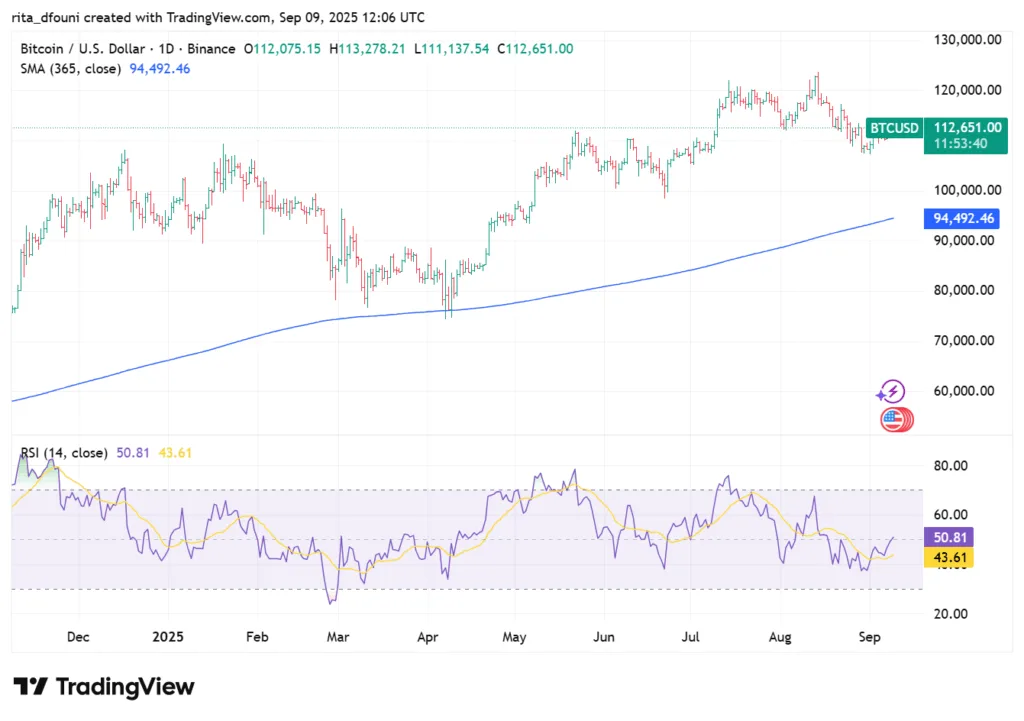
Bitcoin is currently valued at USD 112,935 , having reached an intraday peak of USD 113,237 and a minimum of USD 111,171. These figures define the limits of a market looking for guidance. On the surface, BTC appears to be consolidating, but under that consolidation is a complex interaction of liquidity, institutional movements, derivatives positioning, and investor mentality. This part analyzes Bitcoin over various time ranges and market aspects to offer a comprehensive perspective on its current position and potential future trajectory.
On the intraday scale, Bitcoin has been forming an upward channel for multiple sessions. Whenever the price falls into the USD 111,200–111,800 range, buyers emerge strongly, taking in available supply and driving the market upward again. Analysis of the order book corroborates this trend, displaying substantial bid clusters positioned slightly over USD 111,000. This has established a level that traders are increasingly depending on as a reference for long positions. Conversely, the ceiling has proven to be just as unyielding. The zone between 113,200 and USD 113,400 has consistently thwarted attempts to break out, with each rejection forcing short-term traders to revert to defensive stances.
On the daily chart, BTC shows a bullish structure. The 50-day exponential moving average is approximately USD 109,800 , and the price hasn’t fallen below this level since August. Last week, the moving average convergence divergence (MACD) entered bullish territory, while the histogram kept increasing. RSI is at 54, indicating a balanced momentum. This indicates that BTC has potential to rise further without reaching overbought levels. On the weekly timeframe, the 200-week moving average, frequently viewed as the final long-term support, is positioned around USD 78,500 , significantly below current values. With weekly closes consistently above USD 110,000, Bitcoin is showcasing long-term strength that few serious investors can overlook.
In derivatives markets, futures open interest is consistently rising, now nearing 19 billion USD across leading exchanges. Nevertheless, in spite of this increase, funding rates stay stable, indicating that leverage is being used judiciously rather than irresponsibly. Options markets offer extra perspectives. The bias has moved towards calls, with notable interest in strikes at USD 115,000 and USD 120,000 for December expirations. This stance shows that institutional traders are steadily gearing up for the chance of a breakout rally, yet they are conveying this perspective via optionality instead of unilateral leverage. That differentiation is significant as it indicates a commitment balanced with risk management, a characteristic of an evolving market.
On-chain activity supports this positive perspective. Whale addresses, characterized as ones possessing over 1,000 BTC, have shown net accumulation for three weeks in a row. Exchange flows indicate a net outflow of coins, implying that holders are transferring BTC into cold storage instead of getting ready to sell. The issuance of stablecoins, which serves as an indicator of liquidity in the ecosystem, has started to grow once more after a halt in mid-summer. Combined, these trends suggest that supply constraints are minimal while new investments are slowly returning to the market.
The market structure further emphasizes BTC’s pivotal position. Bitcoin dominance has increased to 54%, indicating that investment is moving towards the most liquid and well-established asset. This is common in the initial stages of a larger rally: investors first invest in BTC before shifting to higher-beta altcoins. The correlation with Ethereum stays strong at 0.82, indicating that BTC’s next move will likely influence ETH’s direction. The relationship with traditional assets is more complex. BTC exhibits a moderate correlation of 0.41 with the Nasdaq, highlighting its dual function as a risk asset and a different form of value storage.
From a technical standpoint, the crucial levels are evident. Support is positioned between 111,200 and USD 111,800 , bolstered by today’s low of USD 111,171 . Resistance is found between 113,200 and USD 113,400 , marked by the current high of USD 113,237 . Should BTC manage to maintain a daily close over USD 113,250 and confirm that level as support, the subsequent targets will be USD 115,000 and possibly USD 120,000. Conversely, a firm close under USD 111,150 would damage the bullish formation, revealing USD 110,000 and potentially USD 109,500.
The situations arising from these levels are clear-cut. In the bullish breakout scenario, BTC surpasses USD 113,250 and gains momentum towards USD 115,000, potentially exceeding USD 120,000 if influxes increase. In the range-bound scenario, BTC fluctuates between 111,000 and USD 113,000, presenting chances for mean-reversion tactics while disappointing trend followers. In the bearish reversal scenario, BTC drops USD 111,150, setting off stops and causing a pullback into the USD 110,000 range. Every scenario has its likelihood, yet the current evidence leans towards consolidation leading to higher outcomes.
Investor psychology introduces an additional aspect. Numerous long-term investors stay untroubled by daily fluctuations, having endured significantly greater volatility in earlier cycles. To them, the support at USD 110,000 and the ongoing investments in ETFs confirm Bitcoin’s position as a long-term asset. For traders, the consistent failures at USD 113,200 generate stress. Every rejection encourages short-sellers, while every support near USD 111,200 boosts buyers. This contest of strength has established a balance where neither party prevails, but the tension is increasing.
Macro conditions sway the scales towards bulls. Anticipations of rate reductions in the United States create a liquidity boost, while institutional investments in Bitcoin ETFs supply a steady demand source. Unless a macroeconomic shock interferes with this alignment, declines are expected to be taken up rapidly.
Ethereum (ETH)
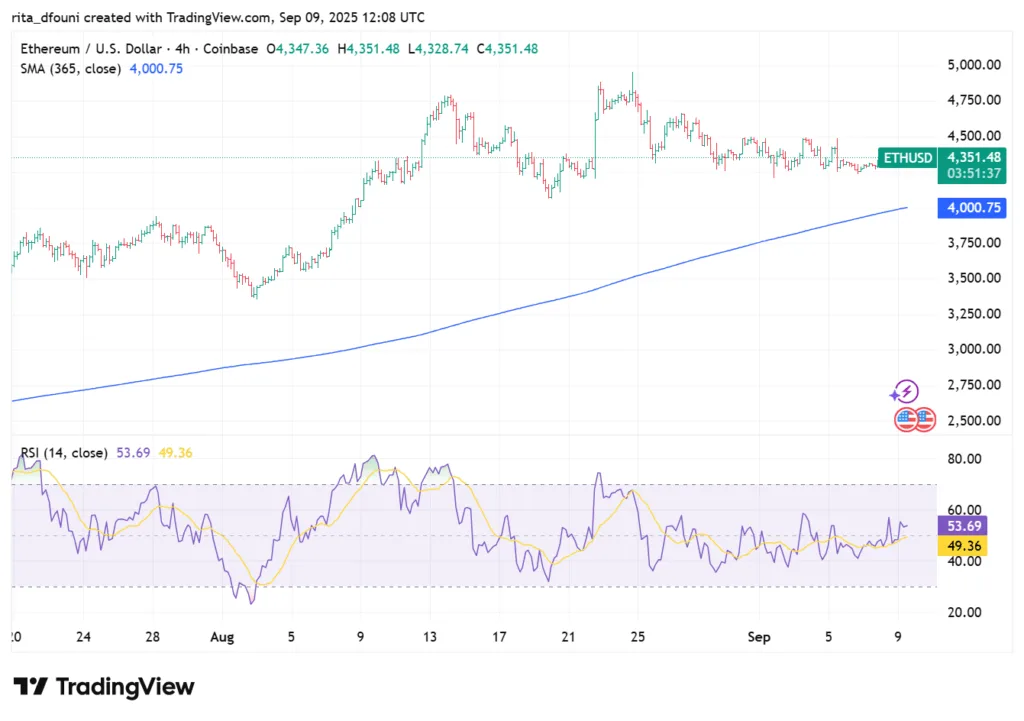
Ethereum is currently valued at USD 4,361, having reached an intraday peak of USD 4,381 and a low of USD 4,279 . The recent price movement in ETH has been characterized by compression over the last few sessions. For almost a week, the asset has fluctuated within a tight range of around USD 100 , stabilizing above USD 4,250 yet consistently struggling to gain acceptance above USD 4,380. Although some may view this as uncertainty, those familiar with Ethereum’s past recognize that extended consolidation frequently comes before major price shifts. The inquiry revolves around whether the outcome will benefit the bulls or the bears, with the answer determined by the intersection of technical frameworks, derivatives placements, on-chain factors, and macroeconomic conditions.
On intraday timeframes like the 1-hour and 4-hour charts, ETH appears to be within a range. Purchasers firmly protect the USD 4,280–4,300 range, while sellers reliably limit movement around USD 4,380–4,400 . Order books validate this impasse: significant buy orders sit just above USD 4,280, whereas stacked sell orders seem to be between 4,380 and USD 4,400 . These liquidity barriers form the intra-day combat zone. Market makers excel in these situations, capitalizing on extremes and earning spreads, whereas directional traders seek confirmation prior to taking substantial positions.
Looking at the daily chart, ETH seems to have a positive outlook. The 20-day exponential moving average at USD 4,250 has served as a dynamic support level, softening pullbacks and strengthening the bullish trend. The RSI on the daily chart stands at 52, indicating a neutral position suggesting the market is not in an overbought or oversold state. This even positioning allows for growth in both directions. The daily MACD histogram is slowly increasing following a phase of compression, suggesting a possible bullish crossover.
The weekly chart provides even greater positive indications. ETH has solidly set USD 4,000 as a foundational floor. That level, which previously acted as strong resistance in early 2025, has now converted into support due to multiple tests. This breakout and ensuing defense exemplify a classic case of previous resistance transforming into fresh support, a trend that reinforces confidence among long-term investors. Weekly closes over USD 4,000 strengthen the case that Ethereum is entering the initial phase of a new upward movement.
Die Derivatemärkte bieten bedeutende Erkenntnisse zur Positionierung. Interest in ETH futures continues to rise, now hitting levels not seen since the beginning of 2024. Notably, funding rates in perpetual futures remain fairly low, suggesting that speculative longs are not overly leveraged. Options flows suggest a positive outlook. Call spreads targeting 5,000 and USD 5,500 for year-end have attracted significant attention, as implied volatility has increased in recent sessions. The options skew has shifted towards calls, suggesting that professional traders believe there is a higher chance of Ethereum trading much above its current levels.
On-chain activity verifies fundamental robustness. Gas fees, although high during times of NFT or DeFi activity, stay reasonable, highlighting Ethereum’s enhanced scalability through layer-2 adoption. The total value locked in Ethereum’s DeFi protocols is roughly 120 billion USD, indicating user engagement and trust in capital. The ecosystem still leads decentralized finance, despite competitors like Solana and Binance Smart Chain gaining ground in certain niches. Ethereum continues to serve as the preferred settlement layer for DeFi and institutional initiatives in tokenization.
Institutional movements also warrant consideration. CME open interest in ETH futures has risen to nearly 9 billion USD, showcasing involvement from professional investors. ETFs and exchange-traded products associated with ETH are starting to attract inflows, although they still fall behind BTC when it comes to absolute figures. The shift in perspective is that Ethereum is now seen not just as a speculative altcoin but as an asset with real institutional applications linked to smart contracts, DeFi, and tokenization.
egarding correlations, ETH has a strong 0.82 correlation with BTC, indicating that Bitcoin’s movements will significantly influence Ethereum’s short-term trajectory. This represents an advantage as well as a drawback. On one side, ETH can benefit from BTC’s rise if the leader moves upward. Conversely, ETH’s capacity to excel on its own is limited when BTC solidifies. Traders should consequently analyze ETH by considering both its own metrics and Bitcoin’s performance.
The key levels for today are clear-cut. Support is focused in the range of USD 4,280 to 4,300 , bolstered by today’s intraday low of USD 4,279. Resistance is established between USD 4,380 and 4,420 , limited by today’s peak of USD 4,381 . Should ETH decisively close above USD 4,380 and maintain that level, the next sensible targets would be USD 4,500 and, with ongoing momentum, USD 4,650. A drop beneath USD 4,275 would jeopardize the bullish outlook, paving the way to USD 4,200–4,220 , with additional risk extending to USD 4,060–4,100.
The situations arising from these levels correspond with outcomes weighted by probability. In a positive scenario, BTC surpasses its resistance level of USD 113,250 , pulling ETH past USD 4,380 . Momentum shifts and aims for USD 4,500 rapidly, with a chance for a push to USD 4,650 if BTC speeds up towards USD 115,000. In the neutral scenario, ETH stays confined within a range, fluctuating between 4,280 and USD 4,380 , disappointing directional traders while presenting chances for mean-reversion tactics. In a bearish scenario, ETH declines to USD 4,275, dropping to USD 4,200 and potentially to USD 4,100 , although this situation presently has a lower likelihood due to favorable macro conditions.
Investor sentiment regarding ETH exhibits a blend of assurance and endurance. For long-term investors, the protection of USD 4,000 as a foundational support reinforces the asset’s path. Numerous institutional investors currently consider ETH the leading programmable asset, enhancing BTC’s position as digital gold. For traders, the continual refusals at USD 4,380 generate pressure. Every setback empowers shorts, while every support around USD 4,280 reinforces buyers. This stalemate is generating the type of stored energy that commonly comes before major breakthroughs.
The broader environment leans the balance in favor of optimism. Expectations for a rate decrease in the United States, along with increasing ETF inflows, establish a favorable environment for ETH as well as BTC. The growth of stablecoins increases liquidity, a significant portion of which ultimately flows into Ethereum-centered DeFi protocols. Barring any macro shocks, ETH seems ready for continuation once the technical breakout has been validated.
Solana (SOL)
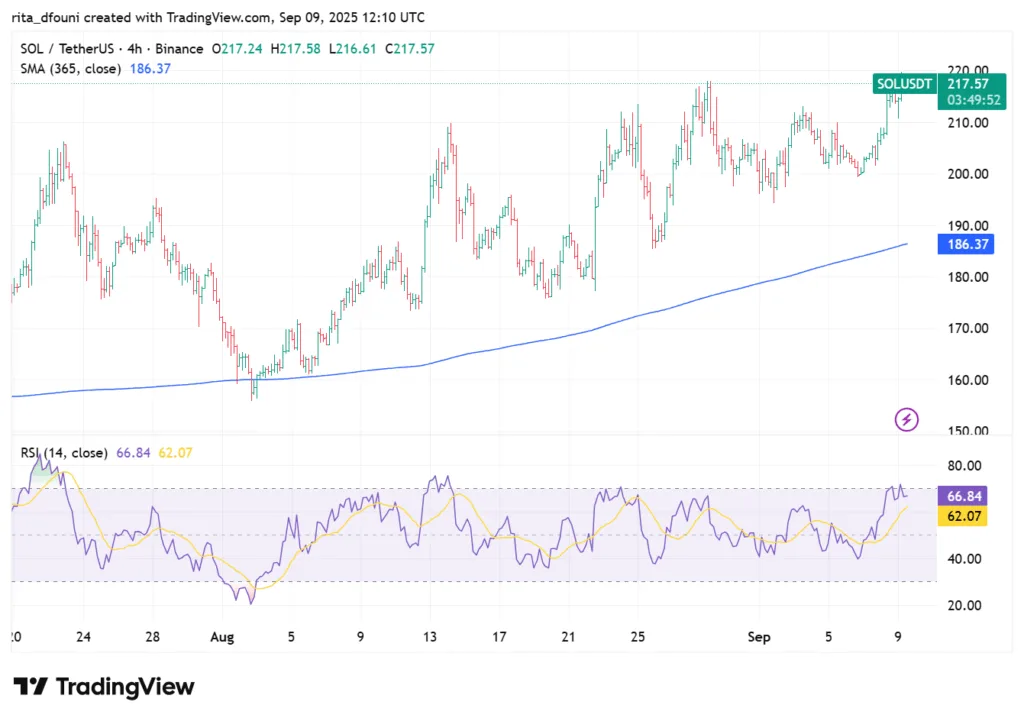
Solana is priced at USD 218.9, having hit an intraday peak of USD 219.7 and a low of USD 209.7 . Today’s price movement of SOL reflects its overall path in 2025: consistent strength, increasing adoption, and an ongoing struggle at key technical levels that may lead to added momentum. Even though Ethereum maintains its lead in total value locked and institutional attention, Solana has become the leading alternative for developers looking for high throughput, low transaction fees, and an active ecosystem of decentralized apps. The current price movement demonstrates that increasing strength, as the asset approaches resistance levels that have held it back in recent weeks.
On shorter-term charts like the 1-hour and 4-hour timeframes, SOL shows the traits of an ascending triangle. Every foray into the USD 210–212 range has encountered strong buying interest, whereas resistance at USD 219–220 has consistently limited upward movements. This coiling pattern indicates buildup: buyers are eager to support higher lows, constricting price movement against a stationary cap. Such configurations generally trend upward, particularly when supported by increasing volume profiles. Order book information verifies this trend. Bid liquidity gathers near USD 212, establishing a strong demand foundation, whereas offers are progressively positioned between 219 and USD 221 . The equilibrium between these two areas determines the current combat zone.
From a daily viewpoint, SOL’s technical metrics continue to look positive. RSI stands at 60, indicating strong momentum without reaching overbought levels. The MACD histogram is in the positive territory, and the MACD line is still above the signal line, indicating persistent bullish momentum. The 50-day EMA is positioned near USD 205 and has reliably offered dynamic support during pullbacks. Whenever the asset fell to USD 205 in the last month, buyers promptly returned, driving the price back up toward resistance. This repeated behavior demonstrates market trust in the 200–USD 205 area as a foundational support level.
Weekly charts support the positive narrative. Since August, Solana has recorded higher weekly lows, firmly staying above USD 200. This steadiness signifies a shift from the more erratic behavior observed in its earlier history, demonstrating a market that has evolved and earned the confidence of bigger capital investors. The weekly RSI rises, and candles exhibit shorter wicks on the bottom, indicating signs of a managed uptrend. For investors with a long-term perspective, this weekly durability is an important indicator of structural stability.
Open interest in SOL futures has been steadily increasing, albeit not at the rapid rate seen in BTC or ETH. Funding rates are marginally positive, suggesting that longs are incurring costs to uphold their positions. Crucially, these funding amounts are moderate, indicating that leverage is not currently excessively imbalanced. Options activity, though less liquid than that for BTC or ETH, indicates a preference for upward strikes near USD 230 and USD 250 . This allocation of open interest indicates that traders believe a move past USD 220 might result in significant extensions.
On-chain fundamentals still bolster Solana’s narrative. Network throughput stays strong, and transaction fees are reliably low, frequently measured in cents. This efficiency has made Solana especially appealing to NFT marketplaces and DeFi protocols aiming for growth. Indeed, Solana has exceeded Ethereum in daily NFT trading volumes several times, showcasing its capability to seize considerable market share. Network stability, a long-standing issue, has significantly enhanced. Following previous years of outages, the protocol has made significant investments in upgrades, leading to improved uptime and dependability. These enhancements have addressed one of the main worries institutions raised regarding Solana adoption.
Institutional investments, though not as prominent as those in BTC or ETH, are starting to take shape. Hedge funds and venture-capital-backed trading companies have heightened their investments in SOL as a component of varied altcoin portfolios. Certain structured products in Asia and Europe have started incorporating Solana alongside Ethereum, indicating a change in view from a speculative asset to a legitimate layer-1 investment. This development mirrors Ethereum’s journey from several years ago and indicates a positive outlook for Solana’s future standing.
Correlation analysis shows that SOL maintains a strong relationship with BTC and ETH but also demonstrates periods of outperformance. In recent weeks, as BTC and ETH consolidated, Solana managed to grind higher, supported by ecosystem news and retail flows. This relative strength often attracts momentum traders, who rotate capital into assets showing leadership. Should BTC break above USD 113,250 , it is likely that SOL would not only follow but also potentially outperform on a percentage basis, given its higher beta characteristics.
The key levels for today’s session are evident. Support is found between USD 210 and 212 , bolstered by today’s low at USD 209.7. Resistance is found between 219 and USD 221, limited by the intraday peak of USD 219.7. A prolonged surge past USD 221 may rapidly push SOL to the USD 228–235 range, with further targets at USD 242–245 . On the other hand, a drop beneath USD 209.5 would weaken the bullish framework, revealing USD 205 and possibly USD 200. The tightening in the present range indicates that resolution is near, with odds leaning towards the upside due to the encouraging environment.
Scenario analysis outlines the potential results. In a positive scenario, SOL surpasses USD 221 , igniting a surge towards USD 235. If momentum picks up, the measured move of the rising triangle targets USD 245, aligning with resistance from earlier in the year. In the neutral scenario, SOL remains in a range between 210 and USD 220, frustrating traders while enabling accumulation to persist. In the bearish scenario, SOL drops to USD 209.5 , cascading to USD 205 and potentially USD 200, although this situation is less probable due to steady buying interest.
Investor sentiment towards Solana showcases a blend of enthusiasm and wariness. Retail investors see SOL as a high-beta option with significant return potential, whereas institutions are increasingly recognizing it as a valid investment alongside ETH. Enhanced network reliability has lessened doubt, while steady acceptance in NFTs and DeFi showcases genuine usefulness. For numerous individuals, SOL signifies the most promising substitute to Ethereum regarding scalability and ecosystem vitality.
XRP
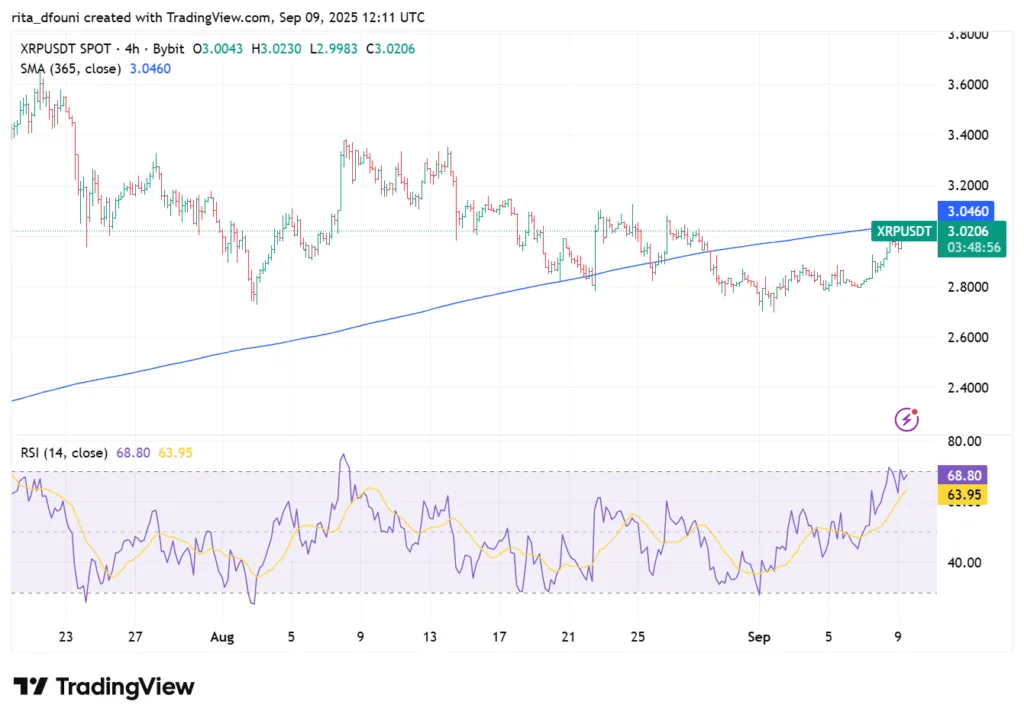
XRP is being traded at USD 3.01 , having reached an intraday peak of USD 3.03 and a minimum of USD 2.92. Among the prominent digital assets, XRP differentiates itself today due to its capacity to maintain momentum at or above the crucial USD 3.00 psychological level. This action reflects not just immediate price movements but also a resurgence of trust among traders and investors. XRP has frequently been influenced by a combination of speculative movements, remittance use, and legal matters. With the legal uncertainties largely resolved and Ripple consistently growing its global presence, the asset is again acting like a market leader.
On the 1-hour and 4-hour intraday charts, XRP is consolidating within a narrow range, staying slightly above USD 3.00. Earlier in the session, the asset jumped over 4%, elevating it from the mid-2.90s to the low 3.00s. The shift was accompanied by a positive MACD crossover, along with the histogram widening in support of momentum buyers. The RSI on shorter timeframes is around 62, demonstrating strong momentum without showing extreme overbought levels. The market is therefore situated in a region where it could either solidify and rise further or retreat towards support if momentum loses strength.
Daily charts provide additional context. XRP has created a solid foundation near USD 2.70 , which has been tested several times in recent weeks. Every descent into the USD 2.70–2.80 range has been met by buyers, resulting in increased lows. This conduct establishes the structural basis for the ongoing rally. The 50-day EMA is around USD 2.85 and has consistently served as a dynamic support, softening pullbacks. With the price now exceeding USD 3.00, XRP is actively developing on this foundation, converting former resistance areas into bases for further progress.
The weekly chart highlights the importance of today’s levels. For several months, XRP had been limited below the USD 3.00 threshold. That ceiling resulted from both technical limitations and psychological reluctance associated with regulatory risks. As Ripple’s legal disputes have mostly ended in its favor, the cloud that impacted investor sentiment has cleared. Consequently, weekly closes exceeding USD 3.00 would signify not just a technical breakout but also a significant milestone. The weekly RSI is rising consistently, and candles display shrinking wicks downwards, indicating that sellers are diminishing their power as buyers take charge.
Derivatives engagement introduces an additional layer to the examination. XRP futures saw open interest jump by 14% overnight, indicating a significant rise in speculative activity. Funding rates became slightly positive, indicating that longs are prepared to pay to maintain their positions. Importantly, funding has not reached excessive levels, which minimizes the chances of a destabilizing liquidation cascade. Options markets, while not as liquid as BTC or ETH, display increasing interest in upside strikes near USD 3.20 and USD 3.50. This skew indicates trader confidence that the move above 3.00 USD is sustainable.
On-chain and fundamental information offer extended context over time. RippleNet keeps extending its network of money transfer routes, especially in Asia and Latin America. This adoption narrative sets XRP apart from various other digital assets, providing it with practical use beyond mere speculation. The capability to enable quick, affordable cross-border transactions continues to be a key element of Ripple’s proposal to financial entities. This framework supports the asset’s validity and provides investors with greater assurance to maintain their positions during times of turbulence.
The liquidity framework in spot markets validates the conflict zone. Bids are clustered between 2.95 and USD 2.98, creating a demand area. Bids range from USD 3.03 to 3.08, matching the current intraday peak. These liquidity walls signify the instant barriers that need to be overcome for progress. A prolonged move above USD 3.03 would probably activate stops and attract breakout buyers, driving the price toward USD 3.20. On the other hand, a drop beneath USD 2.98 would strengthen short sellers and increase the likelihood of a decline to USD 2.92.
Scenario analysis outlines the possible directions ahead. In the optimistic scenario, XRP remains above USD 3.00, surpasses USD 3.03 , and moves rapidly toward USD 3.20. Momentum might propel it to USD 3.30 , where there is earlier resistance from the year. In the neutral scenario, XRP fluctuates between USD 2.92 and 3.03 , consolidating as it absorbs liquidity. In the negative scenario, XRP drops below USD 2.91 significantly, disrupting the structure and prompting a retest of USD 2.85–2.88 . Considering the alignment of technical, derivatives, and fundamental elements, the bullish scenario presently has the greatest likelihood.
Investor sentiment is changing towards a more optimistic outlook. For many years, XRP holders have faced underperformance compared to BTC and ETH, affected by legal uncertainties. The latest rise above USD 3.00 signifies not just a technical surge but also an emotional liberation. Long-term investors feel justified, whereas new participants view an asset with unequal potential for gains. This pairing frequently generates momentum phases where rallies sustain themselves.
The macro context further strengthens the argument for continuation. With expected Fed rate cuts leading to increased global liquidity, investments in higher-beta assets like XRP frequently surge. Though BTC is the foundation, XRP’s comparative strength appeals to traders looking for leverage in the overall market movement. Institutional investments, while still modest, are starting to reconsider XRP baskets, especially in Asia, where Ripple enjoys its greatest adoption.
TRON (TRX)
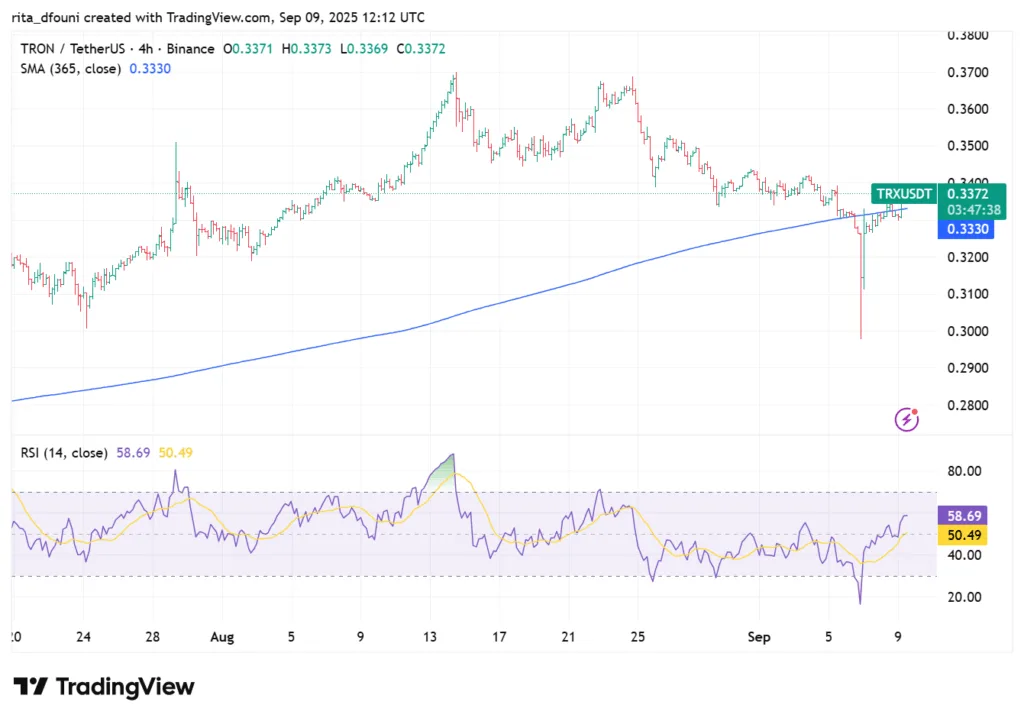
Today, TRON is priced at USD 0.337 following an intraday peak of USD 0.338 and a trough of USD 0.330. At first glance, this range seems limited, and TRX has indeed been less active than some of its counterparts regarding volatility. However, in markets, tranquil phases are seldom without purpose; they frequently signify times of equilibrium before major capital reallocation. The consolidation of TRON around these levels should not be regarded as inactivity but instead analyzed for insights regarding the upcoming directional shift.
On the 1-hour and 4-hour intraday charts, TRX is restricted within a range that spans approximately one cent. The price has fluctuated between USD 0.333 and 0.338, creating consecutive candles with lower volatility. Bollinger Bands on these timeframes are constricting, highlighting the volatility squeeze. RSI stands at 55, indicating a neutral position. Neither buyers nor sellers have claimed superiority yet. The formation looks like a coiling spring, with the more extended price compression leading to a more abrupt release.
From a daily viewpoint, TRX’s narrative is one of subtle perseverance. The asset has reliably remained above USD 0.31, acting as a structural support during the summer. Every time the support zone is tested, it has seen robust demand, leading to elevated lows on daily charts. This positive trend has enabled TRX to gradually rise to its present range in spite of the lack of significant surges. The 50-day EMA is positioned around USD 0.325 and has offered active support during downturns. The MACD lines appear almost level, indicating the compression, yet the histogram is slightly positive, implying a tendency for continuation instead of reversal.
Weekly charts support this positive outlook. Since Q2 2025, TRX has been creating higher lows, gradually rising from the USD 0.27–0.28 area into the mid-0.30s. Weekly RSI trends upward slightly, and candles show shorter downside wicks. This steady, managed progress might not have the excitement of Solana or XRP, but it demonstrates foundational strength. Long-term holders frequently favor these stair-step advancements as they indicate accumulation instead of speculative spikes.
Derivatives activity around TRX is modest but informative. Open interest in TRX futures has remained stable, neither surging nor collapsing, which indicates a balanced derivatives market. Funding rates are close to zero, reflecting an equilibrium between longs and shorts. This lack of leverage makes TRX less prone to sudden liquidation cascades and positions it for smoother moves when volume eventually increases. Options activity, while limited, shows mild interest in upside strikes at USD 0.35 and USD 0.36. These levels correspond with resistance zones from earlier in the year, providing technical anchors for trader expectations.
The core of TRON’s value proposition lies in on-chain fundamentals. The network still leads in stablecoin issuance, especially Tether (USDT). Over fifty percent of all circulating USDT currently exists on TRON, establishing it as a vital component of crypto’s settlement system. This position guarantees a steady baseline demand for the network’s offerings and stimulates transaction activity, even when price performance is lackluster. Although TRON lacks the same degree of developer excitement as Ethereum or Solana, its practical function in stablecoin transactions offers a reliability that is frequently overlooked.
Liquidity in spot markets reinforces the image of equilibrium. Bid clusters are focused within the range of USD 0.330 to 0.333, establishing a zone of immediate demand. Bids range from USD 0.338 to 0.340, corresponding with the intraday peak of today. These liquidity barriers demonstrate why the price has been restricted: both buyers and sellers are confident in protecting their positions. Once one side ultimately concedes, the market will probably shift quickly to the following liquidity area.
Scenario analysis describes the potential results. In a positive scenario, TRX confidently surpasses USD 0.338, activating stops and initiating breakout movements. This action would aim for USD 0.345 at first, potentially extending to USD 0.350–0.355 if momentum increases. In a neutral scenario, TRX persists in fluctuating between USD 0.330 and 0.338, enabling additional accumulation while vexing directional traders. In the pessimistic scenario, TRX drops to USD 0.3295, descending towards USD 0.326–0.327 , where extra buy orders are expected to emerge. Considering the balanced derivatives positioning and robust on-chain utility, the bullish or neutral scenarios seem more probable than the bearish one at this time.
The mindset of investors regarding TRON is distinct in comparison to other major cryptocurrencies. Retail traders frequently consider TRX less thrilling because of its reduced volatility, whereas institutions and major OTC desks value its stability and liquidity in stablecoin transactions. This difference in viewpoint indicates that TRON frequently surges later in the cycle, as funds shift into assets that seem undervalued based on their utility. TRX’s function in settlement infrastructure guarantees its relevance, even when narrative-driven assets capture the spotlight.
Macro conditions offer an extra boost. With the increasing global liquidity, the issuance of stablecoins rises, directly benefiting TRON. An increase in stablecoins issued on the network leads to greater baseline demand for TRX, utilized for transaction fees and infrastructure expenses. This connection between macro liquidity and TRON’s on-chain economy offers a fundamental basis for price, setting it apart from assets whose worth depends solely on speculative movements.
In summary, TRON is currently priced at USD 0.337, restricted to a tight range but backed by solid fundamentals. The critical threshold is USD 0.338. A verified surge beyond this level paves the way to USD 0.345 and possibly more, whereas a decline below USD 0.3295 threatens a shift toward USD 0.326. With derivatives positioning stable, on-chain fundamentals robust, and macro conditions advantageous, TRON is poised for continuation once the present volatility squeeze concludes. For traders, the chance is in predicting the breakout; for investors, the calm consolidation highlights TRON’s reliability as a fundamental element of the stablecoin market.
Cardano (ADA)
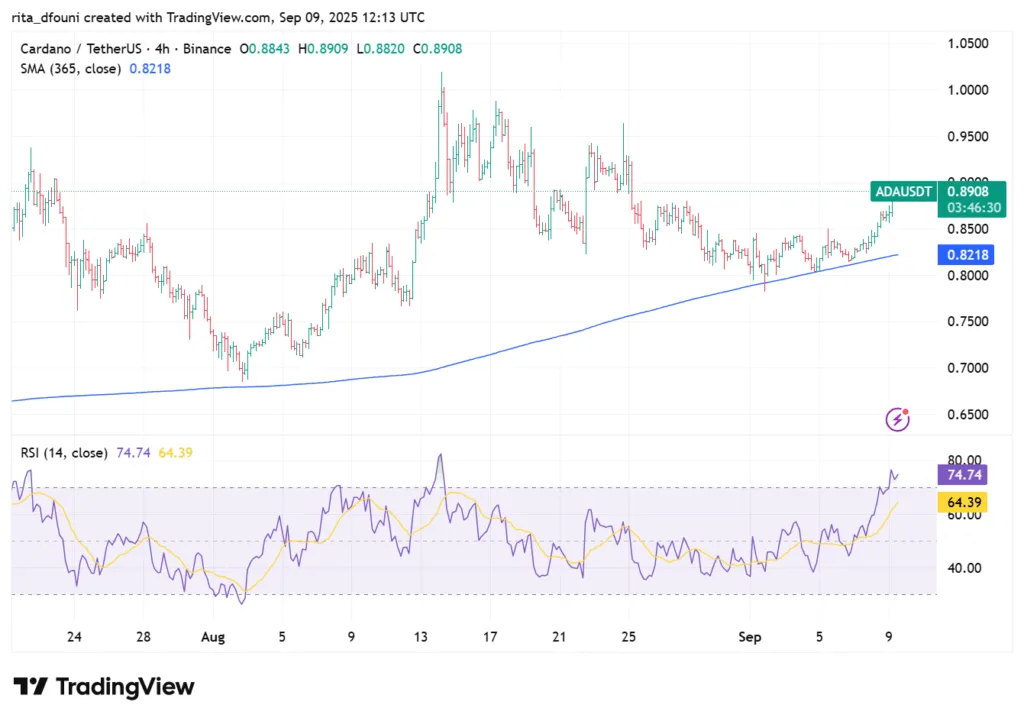
Cardano is presently priced at USD 0.891 , reaching an intraday peak of USD 0.894 and a low of USD 0.847. These figures represent ADA’s present situation: it is lingering just beneath the significant USD 1.00 mark, a point that has been difficult to reach in recent months. For numerous market players, ADA’s inability to recover and maintain a position above USD 1.00 has been frustrating, whereas its steady support of the USD 0.80–0.85 range has provided comfort. This strain characterizes Cardano’s role in the wider digital asset environment as of September 9, 2025.
On shorter-term charts, such as the 1-hour and 4-hour timeframes, ADA exhibits a stabilization pattern. Buyers emerge whenever the price falls near USD 0.85, whereas movements toward USD 0.90 encounter resistance. This behavior has established a limited oscillation range that market makers take advantage of, while directional traders stay wary. Order books validate this balance, showing bids clustered between USD 0.85 and 0.87, while offers pile up slightly below USD 0.90 . These liquidity barriers establish temporary upper and lower limits that govern intraday movements.
From a daily standpoint, ADA’s technical framework indicates consolidation. The RSI is at 49, indicating a neutral position. Price movement stays limited within a downward channel of lower highs, a formation that frequently irritates bullish investors but also indicates managed pullbacks instead of a downturn. The 50-day EMA is located around USD 0.87 , offering dynamic support that has been tested multiple times. Whenever ADA falls to this level, interest arises, pushing the price back up into the upper 0.80s. The MACD remains stable, indicating a lack of prevailing momentum, in line with the market’s uncertainty
Weekly charts showcase ADA’s strength. The USD 0.80 mark has been examined several times in recent months, and every examination has remained intact. This continual defense converts the area into a foundational layer. The weekly RSI moves horizontally, and the candles exhibit shorter downward wicks than earlier this year. Collectively, these indicators imply that sellers are slowly relinquishing control, even though buyers have not yet staged a convincing breakout. For long-term investors, the continuity of the USD 0.80 support level is a comforting indication that ADA’s value proposition is still solid.
Die Derivatdaten bieten zusätzliche Feinheiten. The open interest in ADA futures is notably lower than that of major assets such as BTC, ETH, or SOL, indicating less speculative activity. Funding rates remain neutral, highlighting the absence of intense leverage. Options activity, although limited, indicates some positioning near the USD 1.00 strike. This is not unexpected, as the round figure acts as a draw for both optimistic expectations and pessimistic doubts. The restricted involvement in derivatives indicates that ADA’s upcoming movement will probably be influenced more by spot transactions rather than leveraged bets.
On-chain fundamentals are essential for comprehending ADA’s path. Cardano has consistently been positioned among the leading blockchains regarding development activity. GitHub commits and network enhancements showcase a dedicated group of developers. Nonetheless, adoption indicators in decentralized finance and stablecoin movements trail behind rivals. The total value locked on Cardano is still low in comparison to Ethereum or Solana, which constrains ADA’s utility narrative. The divide between technological advancement and user adoption has consistently been a defining aspect of Cardano’s narrative. Proponents contend that ADA’s systematic strategy will yield benefits over time, whereas detractors highlight lost chances and a decelerated ecosystem development.
Liquidity movements in spot markets reflect ADA’s cautious sentiment. Bids group around USD 0.85, whereas offers gather close to USD 0.90. The USD 1.00 psychological barrier stands out, likely accompanied by denser liquidity obstacles just beyond it. These patterns illustrate the challenges ADA faces in building momentum: every surge into the USD 0.90–1.00 range meets considerable selling pressure. Without a catalyst to breach these barriers, ADA risks staying within a limited range.
Scenario analysis presents three potential trajectories. In the optimistic scenario, ADA recovers to USD 0.905 , turning that level into support. This could lead to a move towards USD 0.96, with an additional chance to reach USD 1.02 if momentum expands among altcoins. In the neutral scenario, ADA keeps fluctuating between USD 0.85 and 0.90, annoying directional traders while permitting accumulation. In a bearish situation, ADA drops to USD 0.847, sliding down to USD 0.82–0.84. All of these scenarios hold value; however, considering the steady support for the USD 0.80 floor and the positive macro environment, the bullish or neutral results seem more probable.
The psychology of investors significantly influences ADA’s narrative. Numerous retail investors who got in at elevated prices see ADA’s present range as subpar, resulting in reduced excitement. Nonetheless, loyal supporters continue to be resolute, highlighting Cardano’s scientific methodology in development and its dedication to sustainability. Institutional involvement is restricted, indicating worries regarding adoption figures, yet certain funds continue to hold ADA as part of varied altcoin portfolios. This difference in perception results in a divided market: patient supporters discreetly gathering, whereas others hold out for explicit technical validation.
The macro context offers a degree of assistance. Increasing global liquidity, propelled by expected US interest rate reductions, generally enhances the overall cryptocurrency market. ADA, being a large-cap asset with considerable liquidity, indirectly gains from these inflows. Yet, it does not have the prompt drivers that stimulate momentum in assets such as SOL or XRP. For ADA to surpass USD 1.00 and maintain elevated levels, it will probably require either a wider altcoin shift or a network-specific trigger like a substantial DeFi project migration or important stablecoin integration.
In summary, Cardano today represents a tale of persistence without a surge. Trading at USD 0.891 , with resistance slightly below USD 0.90 and structural support around USD 0.85 , ADA continues to stay in a range. The critical level is USD 0.905 ; recovering this point would open the path to USD 0.96 and USD 1.02. Not maintaining USD 0.847 could lead to a drop back to USD 0.82. Until one of these levels is settled, ADA will probably keep fluctuating within its defined range. Traders need discipline to engage in the band. Investors must exercise patience to enable Cardano’s systematic development to result in adoption.













